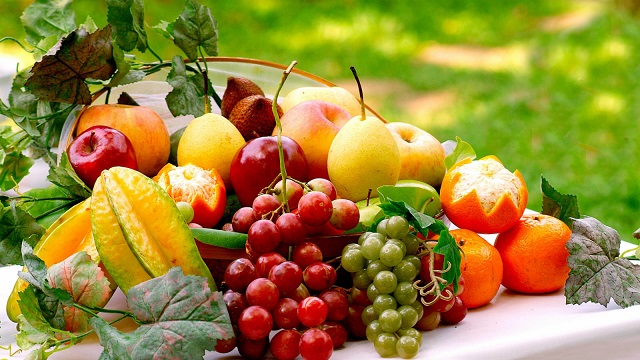Regular fruits intake good for heart

Saul Gwakuba Ndlovu
The 2017/18 first rains have fallen in some parts of the country, ushering in summer with its traditional agricultural activities.
Zimbabwe is by and large an agricultural nation in spite of a large variety of minerals with which its soil is endowed. Most indigenous Zimbabweans till the ground to grow one or more types of vegetables or other crops.
The country’s urban centres have one very common characteristic in the form of tiny gardens in the back yards of residential stands, and little fields in undeveloped municipal lands around the towns.
Most of the produce of those gardens and fields is for the consumption of the various families that own and cultivate them, and not for commercial purposes.
The gardens are for vegetables and most fields produce cereals, especially maize. Very few families have orchards, and only a negligibly few are proud owners of peach, mango, lemon or mulberry trees some of which are virtually semi-wild, that is to say are not properly tended.
Regular fruit consumption is not a part of Bantu culinary culture whose major foods are cereals. Research has established that lack of fruit in our usual diet contributes to the high incidence of one or another of heart diseases: myocardial infarction, cardiac failure, arrhythmia and angina pectoris.
Angina pectoris is characterised by spasms or reversible narrowing of coronary arteries responsible for supplying blood to the heart muscle, in that way enabling it to beat.
Myocardial infarction is a result of a complete obstruction of a coronary artery or one of its branches. It causes tissue death and irreversible damage to the heart muscle.
Cardiac failure is the inability of the heart to pump the necessary volume of blood.
Arrhythmia is simply an alteration in the heartbeat rhythm generally referred to as a palpitation. If that alteration is serious, it can reduce the heart’s ability to pump sufficient blood throughout the body, leading to heart failure.
The likelihood of any of those cardiac conditions occurring can be reduced by the regular consumption of the right kind of fruits some of which are mentioned and described by Dr George Pamplona-Roger, of the University Of Granada, Spain, and a highly respected scientist and author of two important books: Healthy Foods, and Encyclopedia of Medicinal Plants.
Not that regular consumption of fruits can stop the development of one or all of those heart diseases from occurring but it certainly can reduce the factors that cause those ailments, so says Dr Pamplona-Roger.
He is supported by Dr Jean Sabate, Professor and chairman of the Department of Nutrition, School of Public Health, at Loma Linda University, California in the United States.
In a recently published book titled Healthy Foods, Dr Pamplona-Roger says that fruits in general, and red grapes in particular are the best sources of flavonoids, a reference to substances that prevent the accumulation of cholesterol deposits within the arteries, a process known as arteriosclerosis.
He goes on to say that various statistical studies have shown that drinking between half a cup to one cup of red wine a day reduces the risk of death from heart attack, but apparently only for men who are more than 50 years old.
Red grapes can be grown fairly easily in most of Matabeleland because they do not require much rain, hence they are cultivated mainly in the Middle East, especially in Israel, Lebanon, Syria and other countries in the Levant.
Peaches are another fruit recommended for the maintenance of a healthy heart. Originally belonging to China where it was cultivated in large family orchards centuries before the birth of Christ, the peach tree was taken first to some Middle Eastern countries and later to Spain and to the Americans.
The peach tree usually does well in Zimbabwe and Southern Africa in general. Its fruit is particularly good for the heart in that it has much potassium and magnesium, two mineral salts that are essential for the maintenance of a strong, normal heartbeat, so states Dr Pamplona-Roger.
Zimbabweans can very easily grow peach trees on their small urban stands and keep them alive with some of the water they throw away after washing their kitchen utensils.
Yet another dietary beneficial fruit tree is the mango, a native of tropical regions, each area having its own family, albeit with virtually the same or at least similar nutritional qualities.
In Zimbabwe, mangoes are a very common commercial commodity. Large quantities are harvested in various regions, particularly the eastern highlands and are transported to urban markets.
The mango pulp is 81,7 percent water, slightly less than the peach whose water content is 87,7 percent. Nutritionists say that the mango fruit yields 15,2g of carbohydrates per 100g of its edible portion.
It has three types of sugars: fructose, glucose and saccharose. Mangoes contain very little proteins, 0,51 percent, and fats only 0,27 percent.
They have a fairly high vitamin A yield comprising 16 types of carotenoids, a reference to generally yellow or orange vegetable pigments that convert to vitamin A in the human body.
Mangoes are rich in vitamin C, vitamin E and at least three of the vitamin B group. Their vitamin E content is very high.
Research has established that carotenoids are strong anti-oxidants that neutralise oxidising molecules responsible for the aging of body cells.
It has also been established that the consumption of mangoes helps in the maintenance of a healthy skin. Dr Pamplona-Roger tells us that vitamin A deficiency causes skin dryness and scaling, but the eating of mangoes helps in skin hydration and healthy toning.
Raw mangoes can remain fresh for about two weeks in normal tropical temperature, and can be turned into jam and jelly as well as canned as syrup. A healthy mango tree can produce about 25 000 fruits yearly for about a century.
The renowned Dr Pamplona-Roger tells us that diabetes patients can benefit by eating mangoes because they have a positive effect on arteries. He also states that hypertensive people can increase their urine production by consuming mangoes because they are diuretic.
Another seasonally available fruit is the guava. It is one of the very easy to grow fruit trees as it has an extremely extensive root system. Because of that, it is not advisable to grow guava trees near houses, especially bathrooms, toilets and kitchens as the roots of that hardy tree would bore through walls to get to where there is water (hydrotropism).
Dr Pamplona-Roger tells us that a study conducted in India and published in the American Journal of Cardiology found that adding guavas to the daily diets of 61 hypertensive volunteers lowered their systolic blood pressure by 9mm/Hg and the diastolic by 8 mm/Hg.
That was the equivalent of moving from 150/90mm Hg to 141/82mm Hg. He says the result was obtained over a three month period of regular guava consumption. That study can certainly be emulated by Zimbabwean hypertension sufferers, a disease that has killed or crippled hundreds of people.
Bananas are common in Zimbabwe’s urban centres where they are sold virtually in every fruit shop. Dr Pamplona-Roger asserts that bananas are ideal for those suffering from one or more coronary diseases, which are angina pectoris, myocardial infarction, heart failure, and arrhythmia.
Broccoli is also highlighted as being very good for the heart. It is not a fruit, however, but a type of cabbage that falls under the botanical Crucifer family. It is now replacing a cauliflower on many American tables because it causes less flatulence than cauliflower.
Broccoli should be recommended for cultivation by all Zimbabwean commercial gardeners because it is by far the best of all the cabbage family vegetables in terms of its dietary properties.
Its dietary benefits range from carbohydrates to zinc, with up to eight vitamins and six mineral salts being part of its chemical composition. Broccoli has no cholesterol, but is highly rich in vitamin A and a wide range of the Vitamin B group.
Saul Gwakuba Ndlovu is a retired, Bulawayo-based journalist. He can be contacted on cell 0734 328 136 or through email [email protected].








Comments